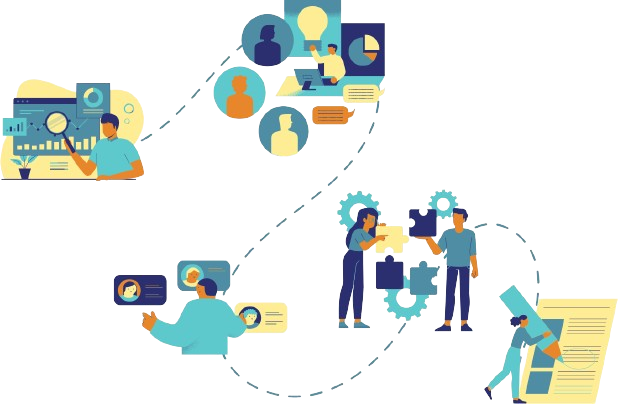Achieving Scalability Step by Step

Introduction to the Transformation Journey
Digital transformation is not just about deploying new technologies—it’s a comprehensive overhaul of business processes and strategies to ensure sustainable scalability and efficiency. This chapter details the “Transformation Journey,” which involves strategic internal changes a company undertakes to effectively scale and deliver digital solutions from initial implementation to widespread adoption.
Establishing a Scalable Framework
The first step in the transformation journey is to define and establish processes that can scale as the company grows. This also includes effective governance structures to maintain control and direction for the company’s scaling.
Step 1: Defining Scalable Internal Processes
- Standardization of Processes: Develop standardized procedures that ensure consistency and quality as operations expand. This helps in managing complexity and reducing variability in the delivery of digital solutions.
- Modular Design: Create modular processes that can be easily adjusted or expanded based on evolving business needs or new market demands.
Step 2: Developing Governance Structures
- Clear Roles and Responsibilities: Define clear roles and responsibilities to ensure accountability and efficient decision-making.
- Regulatory Compliance: Ensure all processes comply with relevant laws and regulations, which is crucial as digital solutions often involve data security and privacy considerations.
Building Capabilities for Growth
As the company grows, having the right talent in place as well as adopting and integrating advanced technologies is crucial for enhancing capabilities and ensuring the scalability of digital solutions.
Step 1: Talent Management
- Recruiting Skilled Personnel: Attract and recruit individuals with the necessary skills and expertise in digital technologies and project management.
- Continuous Learning and Development: Invest in training and development programs to keep the team updated with the latest digital trends and practices.
Step 2: Technology Adoption
- Investment in Technology: Allocate resources for the adoption of new technologies that can improve efficiency and scalability, such as cloud computing, advanced analytics, and enterprise software solutions.
- Integration Systems: Implement systems that ensure seamless integration of new technologies with existing platforms, minimizing disruption and leveraging synergies.
Enhancing Delivery Mechanisms
Implementing Agile methodologies can enhance flexibility and responsiveness, which are key in scaling operations.
Step 1: Deciding on a work mode
- Agile Workflows: Adopt Agile practices to accelerate development cycles and improve responsiveness to client feedback and market changes.
- Cross-Functional Teams: Form cross-functional teams that bring together diverse skills and perspectives, enhancing innovation and problem-solving capabilities.
Step 2: Assuring quality
- Robust Testing Protocols: Establish rigorous testing protocols to ensure that new developments meet quality standards before they are rolled out.
- Continuous Improvement: Foster a culture of continuous improvement that encourages feedback and learning from each project cycle.
Sustaining and Optimizing
Regular monitoring of performance against defined metrics is critical to understanding the impact of the transformation and identifying areas for improvement. At the same time, successfully managing change is essential for ensuring buy-in and minimizing resistance among stakeholders.
Step 1: Performance Monitoring
- KPI Tracking: Track key performance indicators (KPIs) related to process efficiency, customer satisfaction, and financial performance.
- Regular Reviews: Conduct regular reviews to assess progress, discuss challenges, and adjust strategies as necessary.
Step 2: Change Management
- Communication Strategies: Develop clear communication strategies that keep all stakeholders informed and engaged throughout the transformation process.
- Support and Training: Provide comprehensive support and training to help employees adapt to new systems and processes.
Conclusion:
Mastering the Art of Digital Scalability
The Transformation Journey is a continuous process of refining and enhancing internal capabilities to meet growing demands and seize new opportunities. By establishing scalable processes, developing robust governance structures, and continuously building capabilities, leaders can ensure their organizations not only adapt to digital innovations but thrive in a competitive digital marketplace. This chapter provides the strategic insights and practical approaches necessary for navigating this journey successfully, positioning the company for long-term success in the digital era.